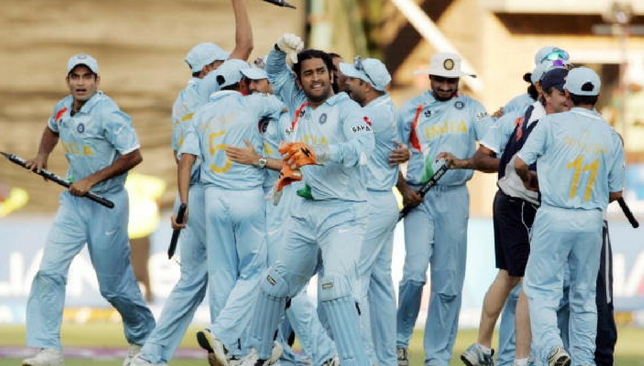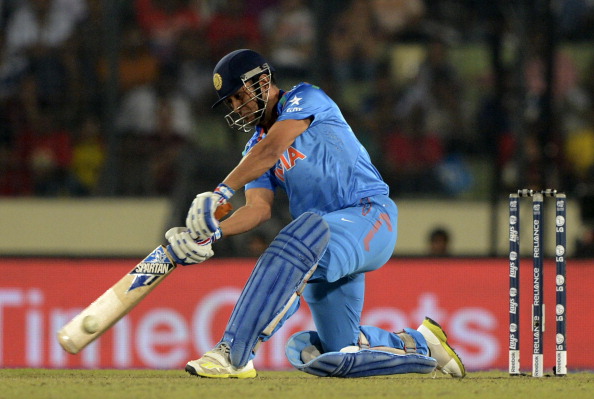
After a marathon tour of England, India’s senior players craved a rest. So the big names spared themselves the worry of taking part in cricket’s latest freak show. It was ‘just’ another tournament in South Africa. For the purists, Twenty20 cricket was unfathomable.
BCCI Secretary Niranjan Shah had said: “T20? Why not ten-ten or five-five or one-one?”
But, yet, this was happening. The top nations were Africa-bound for a world championship of some new, shrunken form of cricket.
India, albeit unwillingly, eventually gave in to the idea of a World T20 and sent a team. A bunch of players were thrown together in a haberdashery mix of cricketers.
I remember a friend saying at the time: “No Sachin, no Dravid, no Zaheer; look at who they’ve selected some bowler from Haryana [Joginder Sharma] some other Sharma from Mumbai [Rohit Sharma] and a bunch of others. I was fancying my chances too.”
Little did he know. Little did we know…

India’s first group encounter was more famous for its position in the schedule as ‘the one before India-Pakistan’. Any of the hype dissipated even quicker when that game against Scotland was washed out without a ball being bowled.
But if that was underwhelming, the follow-up was far from being branded so. The famous rivals served up a thriller, the match ending in a tie that led to a bowl-out.
Deep into the night, India stayed up, so did Pakistan. The genius of Mahendra Singh Dhoni would give its first glimpses in this bowl-out. While Pakistan brought in all their frontline bowlers, Dhoni knew all they wanted was to hit the wickets so he asked his part-timers to turn their arms over.
And so, Virender Sehwag bowled and hit, Yasir Arafat missed, Harbhajan Singh hit, Umar Gul missed, Robin Uthappa bowled and he hit too. Of all people, if Shahid Afridi missed, India would win. The rest is history.
India progressed, into the Super Eights where they lost their first game against New Zealand by 10 runs. Next up was England, a match that saw Yuvraj Singh fired up by Andrew Flintoff before responded with six sixes off a Stuart Broad over, the fastest half-century ever and India won.
INDIAN PREMIER LEAGUE BORN
While this seemingly innocuous team was waking their nation up to the new format, a man named Lalit Modi was working in the background, conspiring to create an indigenous T20 league with a city-franchise system.
People, even within the BCCI, were sceptical. Four days after Yuvraj’s six sixes, Modi pitched the idea of the Indian Premier League (IPL) before a couple of broadcasters and one of them said they were willing to shell out $2bn for the broadcast rights.
By the time India reached the WT20 semi-finals, everyone knew the Indian fan was ravenous for more of this format. And when an Indian cricket fan is hungry for something, it means that the majority of 1.2 billion people were a market ready to be milked.
India’s top notch corporates, Bollywood stars and famous faces would line up to bid for an IPL franchise. The amounts were astronomical, like nothing seen in cricket before.
Meanwhile, India were to face Australia in the semi-finals. Their young team was full of belief, even against the mighty Aussies, and secured a famous win.
Yuvraj’s 70 runs off 30 balls, S Sreesanth’s timely wickets of Adam Gilchrist and Mathew Hayden and some brilliant fielding by the young guns would lead India into the final of the first ever ICC World T20.
This was a different Indian team. Absolutely discernible than the ones we were used to. This team was willing to stand up and stare the opponent in the eyes. They were down at various occasions, but such was their belief that they always found a way to go over.
Suddenly, the Indian team believes in their own ability to dominate. This would go on to change the dynamics of Indian cricket forever.
INDIA vs PAKISTAN
By now, the world was watching, be it willingly or reluctantly. It didn’t matter, we were told this was the future and that the format was the sport’s saviour. Twenty20 cricket had already whet the appetites of so many cricket fans.
India, though, stuttered. Their hero, Yuvraj, failed and save for a fighting knock by Gautam Gambhir, India could only set Pakistan a target of 158. It was below par by the tournament’s standards.
A gruelling chase ensued, during which the pendulum swung constantly. It eventually came down to the last over and after three balls India were World T20 champions.
Bollywood icon Shah Rukh Khan was seen dancing in the crowd along with Lalit Modi. Fireworks went off from every corner of the stadium.
On this day, 9 years ago. We eclipsed the impossible against all odds! #Throwback pic.twitter.com/prQYTuHHoO
— Gautam Gambhir (@GautamGambhir) September 24, 2016
India had only ever played one T20I before this tournament. After it, they would elevate the format to unthinkable heights.
The IPL is today a $4.5bn property and one of the world’s fastest growing sports leagues. But not only did the inaugural World T20 change the landscape of cricketing structure, it breathed new life into Indian cricket as a result of huge financial gains and ushering in a new era of star players.
On 25 June 1983, an innocuous Indian cricket team beat the dominant West Indies to become world champions for the first time and Indian cricket changed forever.
On 24 September 2007, another underdog Indian team became world champions in an entirely different format.
Both those victories instilled a belief in Indian cricket. A belief that they could be world-beaters. A belief that they could be the best.